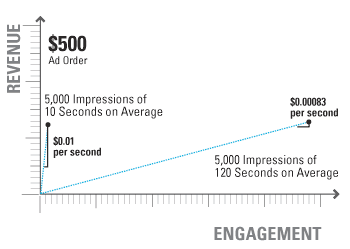Posted by: Matt Shanahan
For publishers, analyzing the unit cost of engagement in advertising identifies revenue optimization opportunities. In the next few blog entries, I’ll explore why and how to analyze the unit cost of engagement for ad orders. This first entry in the series addresses the following questions:
- What is engagement?
- What is the unit cost of engagement, and how is it calculated?
- Why is calculating unit cost important?
What is engagement? For advertisers and publishers, engagement is the length of time the audience spends with media and ad. Engagement is one of the few scarce commodities on the Web. An audience member’s options for news, entertainment, socializing, purchasing, and learning are exploding, and like it or not even with the mobile explosion, any one person has a limited amount of time to provide on any given day. A publisher’s success is premised on maximizing their share of audience time (i.e., engagement) and the revenue it produces.
Today, the publisher’s standard for engagement mistakenly measures the page views rather than length of time. Using today’s standard, there is no difference between impressions that last 1 second, 10 seconds, or 2 minutes which of course doesn’t make sense. Research has shown that the longer a person is exposed to a web page containing an advertisement the more likely they are to remember the advertisement. Additionally, engagement enhances direct response advertising as a recent study published by TidalTV showed click-through rates of targeted ads increase as engagement increases.
What is the unit cost of engagement? Using length of time as the measure for engagement, the unit price of engagement is simply the price paid by an advertiser for each second an impression is delivered to an audience member.
 How do you calculate it? The simple answer is to take the total revenue of an ad order and divide it by the total length of all impressions delivered as part of the order. The chart to the right illustrates the unit cost of engagement. In this chart, two advertisers pay the same $100 CPM rate to a media publisher for the same target audience. The first advertiser’s order resulted in 5,000 impressions with an average length of 10 seconds each or a rate of $0.01/second. The second advertiser’s order resulted in 5,000 impressions with an average length of 120 seconds each or a rate of $0.00083/second (12X lower rate for engagement).
How do you calculate it? The simple answer is to take the total revenue of an ad order and divide it by the total length of all impressions delivered as part of the order. The chart to the right illustrates the unit cost of engagement. In this chart, two advertisers pay the same $100 CPM rate to a media publisher for the same target audience. The first advertiser’s order resulted in 5,000 impressions with an average length of 10 seconds each or a rate of $0.01/second. The second advertiser’s order resulted in 5,000 impressions with an average length of 120 seconds each or a rate of $0.00083/second (12X lower rate for engagement).
Why is calculating unit cost important? With all other factors equal, research has shown that increased engagement improves ad campaign performance both direct response and branding. By calculating the unit cost of engagement for ad orders, publishers can identify which orders were overpriced and which were underpriced.
Overpriced orders have lower engagement per dollar and lower conversion/recall rate per dollar. Advertisers with overpriced orders are less likely to advertise in the future representing revenue risk (e.g., the first advertiser in the example). Underpriced orders have higher engagement per dollar and higher conversion/recall rate per dollar. Advertisers with underpriced orders are more likely to accept a price increase to continue targeting the publisher’s audience (e.g., the second advertiser in the example).
By knowing which audience segments have higher engagement and which advertisers are receiving good value, publishers can price discriminate to optimize their revenues. In the next post, I’ll cover the quantitative method for establishing the unit cost of engagement.






